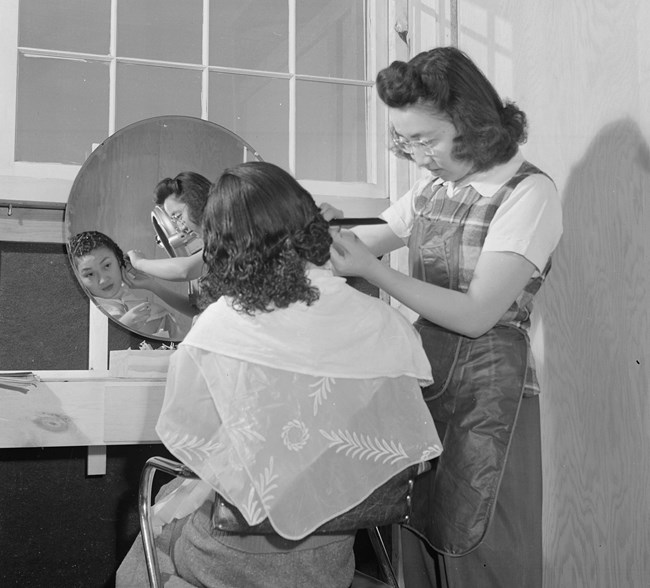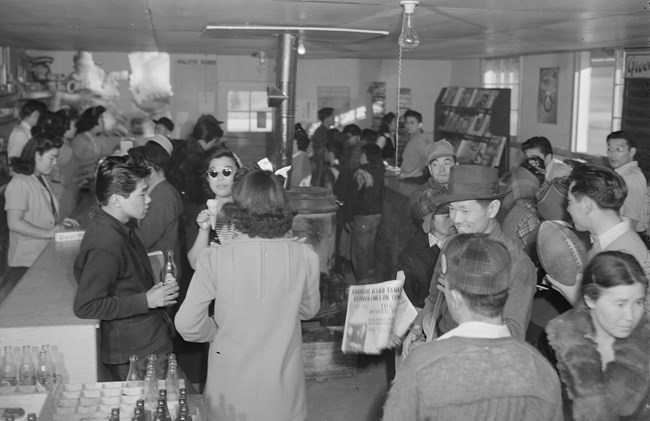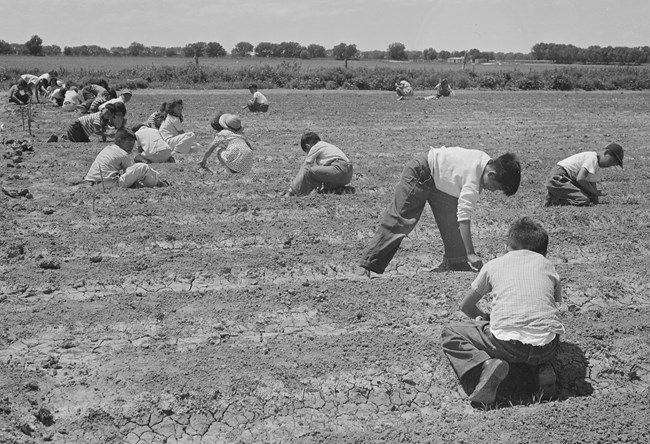Last updated: September 26, 2024
Article
Life Behind Barbed Wire

National Archives
Shared Spaces
The structure of daily life in Amache was drastically different from life outside of incarceration. Cramped, shared spaces and communal dining and bathing robbed incarcerees of their privacy, forcing them to adapt, subvert, and redefine private spaces. Not only could incarcerees hear and be heard by neighbors, but families also lacked physical privacy from each other.Many Japanese American incarceration survivors remember using curtains as substitutes for walls, separating small living and sleeping areas within the barracks. These cramped living conditions often had divisive effects on family unity.
Family life was also strained by how meals were organized. In traditional Japanese culture, mealtime is a time to spend with family. Familial roles are fulfilled, structure is emphasized, and family dynamics are solidified. At Amache, the structure of mealtimes was disrupted by being forced into the public arena.

National Archives
One of the most challenging aspects of communal life in confinement involved the public performance of personal hygiene activities such as showering and using the toilet. The public latrine was split into a women’s side and a men’s side and included a row of exposed toilets and showers, with no dividers or walls to offer even a modicum of privacy. Incarcerees adopted an array of tactics and tricks to cope with this transition, including walking to the bathhouse covered in bathrobes, wearing geta (Japanese wooden sandals) in the shower, bringing in different materials like cardboard and sheets to create dividers, and employing the use of chamber pots to avoid walking to the latrine in the middle of the night.
Finding Work
Like a city, Amache relied on a planned and managed infrastructure that provided basic services and necessities that addressed health, safety, and governance. Amache included many specialized departments and programs, such as the hospital, fire department, police department, and an agricultural program just to name a few. All of these were overseen and supervised by WRA personnel, but incarcerees were either strongly encouraged to participate in these programs or specifically recruited as the government took advantage of the incarcerees for their cheap labor.
National Archives
The skill and experience of Japanese American farmers was also something that the WRA took into consideration as they aimed to operate self-sufficient sites. Intensive and extensive agricultural programs were deliberately set up at each of the camps, with the intention of harnessing the knowledge and labor of the seasoned Nikkei farmers to grow food for each camp’s population. The 8,860 acres of land that lay outside Amache's central project area were intended for use in agricultural production.
Amache, though the smallest of the incarceration camps, had one of the largest agricultural programs; it grew enough produce to be used at Amache, distributed to other incarceration camps and the US military, or sold. The farm program produced 2.7 million pounds of vegetables in 1943 and an even more impressive 3.3 million pounds in 1944. Not only were common vegetables such as onions, tomatoes, and potatoes grown, but other crops, not usually grown in the area, such as daikon, Chinese cabbage, and mung beans were also successfully grown.
